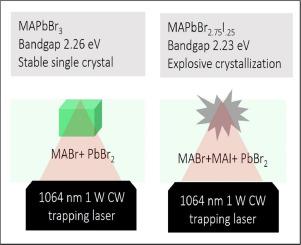Journal of Molecular Structure ( IF 4.0 ) Pub Date : 2023-12-21 , DOI: 10.1016/j.molstruc.2023.137322
Md. Jahidul Islam , Kaushik Pal , Mohammad Margub Abdullah , Mohammad Harun-Ur-Rashid

|
The remarkable optoelectronic properties of hybrid halide perovskites position them as pivotal materials for the next generation of electronic devices, LEDs, lasers, and solar cells, potentially revolutionizing these technological domains. In this study, we harness the capabilities of contemporary laser trapping technology—a non-contact method for manipulating particles—to elucidate the conditions necessary for stable perovskite crystal formation. Using a 1064 nm near-infrared (NIR) continuous-wave (CW) laser, commonly selected for trapping experiments, we establish the threshold bandgap essential for the stable crystallization of MAPbX3 perovskite crystals. Our research reveals that MAPbI3, with a bandgap of 1.59 eV, undergoes rapid explosive crystallization when subjected to the 1064 nm laser, making it unsuitable for stable crystal growth. In contrast, MAPbBr3 with a bandgap of 2.26 eV forms stable single crystals within 6 min at the air-solution interface, when exposed to the same 1064 nm NIR laser at 1.0 W output power. Notably, a minor reduction in bandgap to 2.23 eV in the mixed halide MAPbBr2.75I0.25 results in an abrupt transition to explosive crystallization. These findings introduce a novel insight into the bandgap dependency for the crystallization process, delineating a threshold bandgap of 2.26 eV for MAPbBr3, below which the crystal growth becomes unstable under a 1064 nm laser. The study provides a significant advancement in the field by defining the precise bandgap necessary for the formation of robust, stable perovskite crystals using laser trapping techniques. This threshold bandgap knowledge is crucial for developing controlled synthesis protocols for perovskites, optimizing their optoelectronic properties for application in modern technologies. Moreover, the investigation suggests that to achieve stable crystallization of perovskites with a bandgap below 2.26 eV, laser trapping with wavelengths longer than 1064 nm may be required, opening new avenues for material processing and device fabrication.
中文翻译:

通过近红外激光捕获制备稳定单晶的卤化铅杂化钙钛矿的阈值带隙
混合卤化物钙钛矿的卓越光电特性使其成为下一代电子设备、LED、激光器和太阳能电池的关键材料,有可能彻底改变这些技术领域。在这项研究中,我们利用当代激光捕获技术(一种操纵粒子的非接触方法)的能力来阐明稳定钙钛矿晶体形成所需的条件。使用常用于捕获实验的 1064 nm 近红外 (NIR) 连续波 (CW) 激光器,我们建立了 MAPbX 3钙钛矿晶体稳定结晶所必需的阈值带隙。我们的研究表明,带隙为1.59 eV的MAPbI 3在受到1064 nm激光照射时会发生快速爆炸结晶,使其不适合稳定的晶体生长。相比之下,当暴露于输出功率为 1.0 W 的相同 1064 nm NIR 激光时,带隙为 2.26 eV 的MAPbBr 3在空气-溶液界面处 6 分钟内形成稳定的单晶。值得注意的是,混合卤化物 MAPbBr 2.75 I 0.25的带隙小幅降低至 2.23 eV ,导致突然转变为爆炸结晶。这些发现对结晶过程的带隙依赖性提出了新的见解,描绘了 MAPbBr 3的 2.26 eV 阈值带隙,低于该阈值,晶体生长在 1064 nm 激光下变得不稳定。该研究通过定义使用激光捕获技术形成坚固、稳定的钙钛矿晶体所需的精确带隙,在该领域取得了重大进展。这种阈值带隙知识对于开发钙钛矿的受控合成方案、优化其光电特性以在现代技术中应用至关重要。此外,研究表明,为了实现带隙低于 2.26 eV 的钙钛矿的稳定结晶,可能需要波长超过 1064 nm 的激光捕获,这为材料加工和器件制造开辟了新途径。































 京公网安备 11010802027423号
京公网安备 11010802027423号